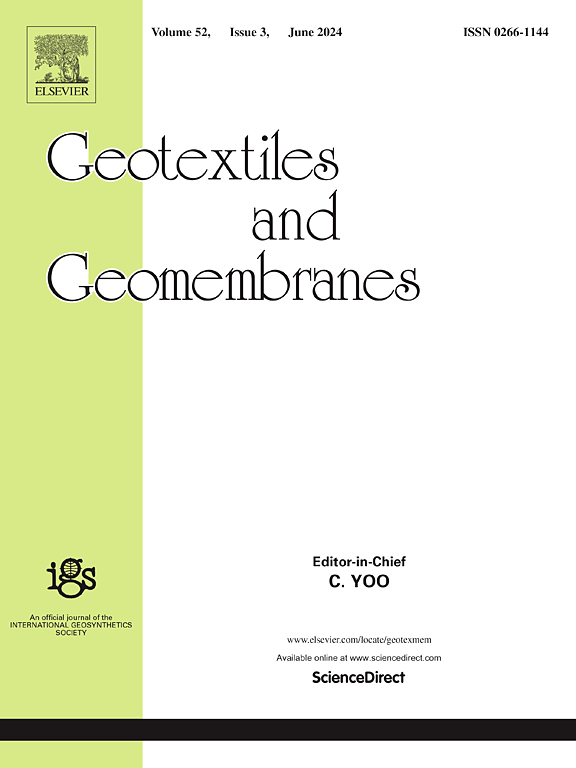Field performance of erosion control on Lamtakong dam slopes using geocell and ruzi grass cover: A case study
IF 6.2
1区 工程技术
Q1 ENGINEERING, GEOLOGICAL
引用次数: 0
Abstract
This study investigates the field performance of an integrated erosion control system combining geocell reinforcement and Ruzi grass cover on 30°, 45°, and 60° slopes at Lamtakong Dam, Thailand. Simulated rainfall intensities of 100, 130, and 170 mm/h were applied to assess the effects of geocell coverage patterns and vegetation maturity on runoff and sediment transport. Results show that full geocell coverage (C100) achieved the highest erosion resistance, reducing runoff and sediment by up to 90 % and 98 %, respectively. Partial coverage (C60 and C80) also proved effective, achieving comparable reductions (RRR of 60–75 % and SRR of 65–78 %) while offering cost-saving potential. Ruzi grass alone reduced sediment concentration by up to 75 % after 8 weeks, emphasizing the importance of vegetation maturity. Discontinuous geocell layouts performed similarly to continuous ones at equivalent coverage, indicating that total coverage area, not pattern, governs performance. A multiple regression model was developed to predict sediment reduction based on geocell coverage, Ruzi grass age, slope angle, and rainfall intensity, confirming the dominant influence of geocell coverage and vegetation maturity. The findings support the integrated system as a sustainable and scalable solution for erosion-prone slopes under varying environmental conditions.
土工格室与芦子草覆盖对兰竹洞坝坡面侵蚀控制的现场效果研究
本研究调查了泰国Lamtakong大坝30°、45°和60°边坡上结合土工格室加固和Ruzi草覆盖的综合侵蚀控制系统的现场性能。采用100、130和170 mm/h的模拟降雨强度来评估土工格室覆盖模式和植被成熟度对径流输沙的影响。结果表明,全土工格室覆盖(C100)达到最高的抗侵蚀能力,减少径流和泥沙分别高达90%和98%。部分覆盖(C60和C80)也被证明是有效的,在提供节约成本潜力的同时,实现了类似的减少(RRR为60 - 75%,SRR为65 - 78%)。8周后,仅如子草可使沉积物浓度降低75%,强调了植被成熟度的重要性。在相同的覆盖范围下,不连续的土工单元布局的表现与连续的土工单元布局相似,这表明控制性能的是总覆盖面积,而不是模式。建立了基于土工格室盖度、如子草年龄、坡角和降雨强度的多元回归模型预测减沙量,证实了土工格室盖度和植被成熟度的主导影响。研究结果表明,在不同的环境条件下,集成系统是一种可持续的、可扩展的解决方案,适用于易侵蚀的斜坡。
本文章由计算机程序翻译,如有差异,请以英文原文为准。
求助全文
约1分钟内获得全文
求助全文
来源期刊

Geotextiles and Geomembranes
地学-地球科学综合
CiteScore
9.50
自引率
21.20%
发文量
111
审稿时长
59 days
期刊介绍:
The range of products and their applications has expanded rapidly over the last decade with geotextiles and geomembranes being specified world wide. This rapid growth is paralleled by a virtual explosion of technology. Current reference books and even manufacturers' sponsored publications tend to date very quickly and the need for a vehicle to bring together and discuss the growing body of technology now available has become evident.
Geotextiles and Geomembranes fills this need and provides a forum for the dissemination of information amongst research workers, designers, users and manufacturers. By providing a growing fund of information the journal increases general awareness, prompts further research and assists in the establishment of international codes and regulations.
 求助内容:
求助内容: 应助结果提醒方式:
应助结果提醒方式:


